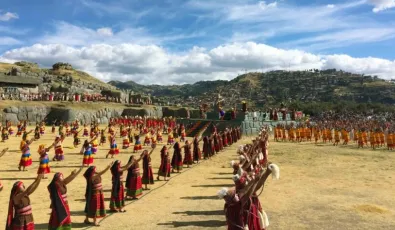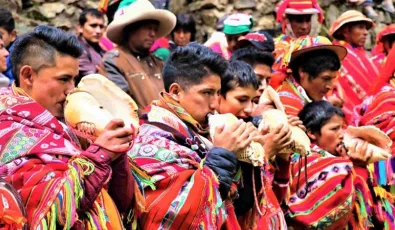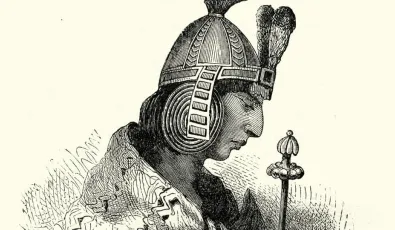The Inca gods were central to the spiritual life of the empire that stretched across the Andes. Gods like Inti, the sun god, and Pachamama, the earth goddess, were honored in daily rituals and large temples. These gods helped the Inca people live in balance with nature and the world around them.
The Incas were an advanced civilization that flourished in South America around the 14th century. Although much of their technology and architecture is no longer extant, many aspects of their culture and religion still survive today; in this article, we will explore what makes the Inca gods important.
Inca Mythology and Religion
The Inca civilization, one of the greatest societies of ancient America, was deeply connected to its mythology and religion. Spirituality was a central part of the Incas' everyday lives. Their beliefs included many gods and spirits that reflected their close relationship with nature and the universe.
Inca religion
The Inca worshippers practiced polytheism, meaning they worshipped multiple gods at the same time. While Inti, the sun god, was the most revered, other important gods included Mama Killa, the moon goddess; Illapa, the god of thunder; and Pachamama, the earth goddess.
The Inca believed that their gods could directly influence their lives and communicate with them. To maintain the balance of nature, they made sacrifices, offering animals and valuable items to honor and please these gods.
The Inca religion also emphasized the importance of honoring ancestors. They believed their ancestors had a special connection with the gods and could help guide their destiny by speaking on their behalf. The Inca showed great respect for their elders and wanted to ensure their happiness in the afterlife.
Reciprocity was a fundamental principle in the Inca religion. They believed that by showing respect and honoring their gods, they would receive the gods' favor in return. This idea of reciprocity was central to all aspects of their lives.
History of the Inca Religion
The Inca religion developed from the beliefs of earlier Andean civilizations. It was heavily influenced by the Tiwanaku culture, which existed long before the rise of the Inca Empire and dominated the region around Lake Titicaca.
In the Inca religion, Viracocha was revered as the chief god and believed to be the creator of all things. However, the Spanish conquest of South America brought an end to both the Inca Empire and their traditional religion. Despite this, many of their beliefs and practices have been preserved by indigenous communities living in the Andean mountains.
Priests and Religious Organizations
The Inca religion was well organized, with priests playing a major role in leading rituals, interpreting signs from the gods, and managing temples. The High Priest of the Sun, or Willaq Umu, was the highest religious leader and served as the main connection between the Sapa Inca (the emperor) and the gods. Temples like Inticancha (Coricancha) were run by dedicated priests and priestesses who performed daily rituals and managed offerings.
Religious training was strict, and young boys were often chosen from noble families to become priests. They were taught astronomy, religion, and fortune-telling, becoming skilled at reading the stars, weather patterns, and other natural signs to predict events and guide farming practices.
Inca rituals and ceremonies
The Inca rituals and ceremonies were a big part of everyday life and were important for the social, political, and spiritual well-being of the Inca people. From big festivals to simple daily offerings, these rituals showed the Inca people's deep respect for their gods and their environment.
Inti Raymi Festival
One of the most important Inca ceremonies was Inti Raymi, the Festival of the Sun. This major celebration took place every year on June 21st, the winter solstice, when the sun is furthest from the earth. The festival was dedicated to Inti, the Sun God, who was the most important god in the Inca religion and believed to be the ancestor of the Inca rulers.
Due to colonial influence, the date of the Inti Raymi festival was changed from June 21st to June 24th, aligning it with the Christian feast of St. John the Baptist and the shift from the Inca calendar to the Gregorian calendar. Furthermore, June 24th is also celebrated as Farmer's Day ("Día del Campesino") in Peru, honoring agricultural workers. This dual significance has reinforced June 24th as a day of cultural and agricultural celebration in Peru.
Capac Cocha (Human Sacrifice)
Capac Cocha was a sacred Inca ritual involving human sacrifice, performed only during extraordinary events like natural disasters or the death of an emperor. The Incas believed that offering individuals deemed pure, such as children or prisoners of war, who had fewer attachments to the material world, would make the sacrifice more potent and more pleasing to the gods.
The most famous discovery related to Capac Cocha is the "Children of Llullaillaco," found in 1999 at the summit of Mount Llullaillaco in Argentina. Three well-preserved mummies—two girls and one boy—were discovered, believed to have been sacrificed in a Capac Cocha ceremony. Their clothing, hair, and skin were almost perfectly preserved, providing researchers with valuable insights into the details of the ritual and the lives of these children before their sacrifice.
Honoring Pachamama
Pachamama, the Earth Mother, was one of the most important gods in Inca mythology. The Incas believed she gave life, fertility, and good crops. To honor her, they performed daily rituals and made offerings, especially during planting and harvest. These offerings, called "despachos," were small bundles of coca leaves, maize, chicha (a traditional corn beer), and other foods, which were buried or placed in sacred spots to seek her blessings.
August was a key month for honoring Pachamama, as it marked the start of the agricultural year. During this time, the Incas performed special rituals to ask for a good growing season. The offerings and ceremonies in August were more elaborate, reflecting their deep connection to the land and their respect for the Earth Mother.
Capac Raymi
Capac Raymi was a major festival in the Inca calendar, celebrated during the December solstice, marking the beginning of the rainy season and the start of a new agricultural cycle. Also known as the "Feast of the Royal House," this festival was a significant rite of passage for young Inca boys, especially those from noble families, as they transitioned into manhood. It was one of the most important celebrations in the Inca Empire, filled with rituals, dances, and offerings to honor the gods and ensure a successful harvest in the year ahead.
The most important Gods of the Incas
The Incas worshipped many gods, and polytheism was common among their beliefs. Their people believed in three main gods: Inti (sun god), Viracocha (creator god), and Pachamama (goddess of fertility).
The Sun God - Inti
Inti, or Inte, was an important deity in the Inca religion. People believed he was Viracocha's child and believed he gave life and light. Peruvians revered Inti as their Sun God/Fire God, and his cult was especially revered in Cusco.
People traditionally imagined Inti as a golden disk with rays emanating from it, sometimes depicted with human features. The colors red and yellow, symbolizing the sun's heat and light, were associated with him, along with offerings of gold, silver, or copper, metals highly valued by Inti. The Incas believed that Inti brought daylight every morning when he emerged from his cave in the east and that he returned there at nightfall, leaving darkness on Earth upon passing away.
To worship Inti, the Incas built the Coricancha temple in Cusco, which was the most sacred site in their empire. They held festivals like Inti Raymi during the winter solstice to honor him and ask for good harvests.
›› Read more about Inti Raymi - The Festival of the Sun
Viracocha - Wiracocha
Viracocha, also known as Wiracocha, was worshiped as the supreme god by the Inca people throughout their empire. They depicted him as an elderly male with long hair and wearing an elaborate llama skin cloak. These people believed he created everything in existence and brought light and brightness to the world. Additionally, the Incas believed he would return and bring peace and prosperity back onto earth one day.
Though he wasn’t worshipped as widely as Inti, Viracocha was still an important god. Sacred sites like Lake Titicaca were connected to his creation story, and people made pilgrimages to these places to honor him.
Mother Earth - Pachamama
Pachamama, or Mother Earth, was revered by the Incas as the source of all life on Earth. They believed she existed within mountains, rivers, and lakes around them as an all-powerful female figure who connected all living things and provided nourishment and sustenance for survival.
The Incas believed that by treating Pachamama well, she would provide them with everything they needed. They celebrated her with grand events and constructed places dedicated to her worship. People still revere her today throughout South America and offer sacrifices as an offering.
The Incas made daily offerings, or "despachos," to Pachamama, especially during planting and harvest times. August was an especially important month for these rituals, as they asked for her blessings for a good growing season.
Apus: The Mountain Spirits
Apus were the spirits of the mountains, believed to protect the people and the land. Each mountain was thought to have a spirit that could impact the well-being of local communities.
People offered food, coca leaves, and chicha to the Apus and made pilgrimages to sacred mountains to seek blessings and protection from these powerful spirits.
The Moon - Mama Killa
Mama Killa was an integral goddess in the Inca religion and was worshiped as their patron deity by both royalty and commoners. Her temple could be found in Cusco. Mama Quilla represented the fertility of land and people alike, helping ensure crops grew well and children were healthy births.
To honor Mama Killa, the Incas built temples and offered silver, which was linked to the moon. Women had special roles in the ceremonies dedicated to her, reflecting her importance.
Mother of the sea - Mama Cocha
Mama Cocha was the goddess of the sea, who played an important role in protecting marine life and ensuring it stayed healthy and fertile. She was also believed to safeguard sailors and fishermen, making her an essential deity for those living along the coast.
Coastal communities offered prayers and sacrifices to Mama Cocha to seek safe passage on the waters and abundant fishing.
God of tremors - Pachacamac
Pachacamac was revered by people living along the coast and in the Andean mountains as a creator god, often confused with Viracocha. He was believed to live on a hill overlooking Lima, an area often affected by earthquakes and natural disasters. His worship was crucial in seeking protection from such calamities.
Incas performed rituals and offered sacrifices to appease Pachacamac, hoping to prevent earthquakes and maintain safety in their communities.
God of Thunder - Illapa
Illapa was the god who controlled weather events such as lightning, rain, and hailstorms. People would offer sacrifices to Illapa to make him happy and prevent adverse conditions, such as Lllama fetuses, which were believed to please this deity.
Kon: The God of Rain and Wind
Kon was the god of rain and wind, which was especially important for coastal areas. He was believed to control the weather, which was vital for both fishing and farming.
Coastal communities worshipped Kon by offering things like shells and feathers to ensure good weather and enough rain for their crops.
The Rainbow - Kuychi
Kuychi was the god associated with rain and fertility. The Incas believed that he brought rain to nourish the earth. People would offer gifts such as llamas or other animals to Kuychi, and sometimes, in extreme situations, even children were sacrificed to show respect and gain favor.
Kuychi's festival usually took place in December when the rainy season began, highlighting his importance in bringing fertility and abundance.
The Stars - Chaska
Chaska was honored as the spirit of the stars. The Incas believed that stars held immense power and would often offer gifts to them in exchange for guidance and protection. This belief highlighted the Inca's respect for celestial bodies and their influence on daily life and agriculture.
God of the death - Supay
Supay was the god of death and the ruler of the underworld. He was connected to the spirits of the dead and had a dual nature, being both protective and fearsome.
The Incas held rituals to honor Supay during funerals and other death-related ceremonies. These rituals were meant to ensure the dead's safe journey into the afterlife.
Sacred Animals in the Inca Religion
In the Inca religion, many animals were considered sacred and very important. Some of the most important animals were pumas, condors, and snakes, each representing different parts of Inca beliefs. Other animals also had special meanings and played important roles in their spiritual traditions.
The Incas believed the world was divided into three parts, known as the Inca Trilogy. The gods lived in Hanan Pacha, the upper world where the sun rises. Humans lived in Kay Pacha, the middle world where daily life happens and the moon sets. Ukju Pacha was the underworld, the place of the dead. Three animals—the condor, the puma, and the snake—represented these three realms.
The Condor
The condor was seen as a sacred bird and a messenger from the gods. It was often used in religious ceremonies. The Incas believed the condor could fly higher than any other bird and had the power to see into the future. As a symbol of Hanan Pacha, the condor connected the people with the gods and the heavens.
The Puma
The puma was an important symbol in Inca religion. It represented strength and guidance in life. The Incas believed the puma protected homes and families and was linked to Kay Pacha, the world of the living. The puma symbolized power and courage and was thought to help keep balance in the world.
The Snake
The snake was believed to have special powers and was linked to Ukju Pacha, the underworld. The Incas thought that snakes could connect with the underworld and help people understand the mysteries of life and death. The snake was seen as a symbol of change and renewal.
The Llama
Llamas were highly valued in Inca culture. They were used for carrying goods, for meat, and for their wool. The Incas believed llamas were gifts from the gods and played an important role in religious rituals. Llamas were seen as sacred animals that could help with farming and provide food, making them important to both daily life and spiritual practices.
The Fox
The fox was admired for its cleverness and ability to survive. The Incas saw the fox as a symbol of intelligence and strategy, traits given by Viracocha, the god of creation. The fox's ability to adapt to different environments made it a respected animal in Inca mythology.
The Dog
Dogs were considered sacred by the Incas. They were believed to help guide souls to the afterlife. People often buried their dogs with them, believing that dogs would protect them from harmful spirits. The dog was seen as a loyal companion in both life and death, guiding the soul on its journey.
The Bear
The bear was a symbol of strength, power, and courage. The Incas believed bears were the spirits of ancient warriors who came back to protect them. The bear represented mental and physical strength and was thought to be a powerful guardian.
Afterlife in Inca Religion: A Journey Beyond Death
In the Inca religion, the afterlife was seen as a continuation of life, influenced by a person's actions and behavior while they were alive. The Incas believed that when someone died, their soul began a journey to one of three places: Hanan Pacha (the upper world), Kay Pacha (the earthly world), or Ukhu Pacha (the underworld).
Hanan Pacha: This was the upper world, like a heaven, where souls went if they lived good and honest lives. These souls would join the sun god Inti or the creator god Viracocha and live in peace and light forever.
Ukhu Pacha: This was the underworld, a place where souls went to reflect and cleanse themselves. Those who lived less virtuous lives or died in unexpected ways faced challenges here before possibly moving to a better place.
Kay Pacha: This is the earthly world where people lived their daily lives. The Incas believed that after death, some spirits stayed close to their families, influencing daily life and needing respect through rituals and offerings.
Ancestor Worship and Mummies
Ancestor worship was very important to the Incas. They mummified their ancestors, especially those of high status, and kept them in shrines or brought them out during special ceremonies. These mummies were believed to protect the living and act as messengers between humans and gods. They were given regular offerings like food and drink to keep them happy.
Preparing for the Afterlife
To prepare for the afterlife, the dead were often buried with important items such as pottery, tools, and food to help them on their journey. For important people, like nobles, funerals were very elaborate to ensure a good place in Hanan Pacha or an easier journey through Ukhu Pacha.
Moral Code and Priests
The Incas followed a simple moral code: Ama Sua, Ama Llulla, Ama Quella (Do not steal, do not lie, do not be lazy). This code was believed to affect their fate in the afterlife. Priests, known as Amautas, performed special rituals to help guide souls on their journey, acting as a bridge between the human world and the gods.
The Inca view of the afterlife shows that they saw death not as an end but as a step to another life. They believed in living in harmony with the gods, honoring ancestors, and respecting the natural world, which would help ensure a good journey after death.
The Impact of Christianity on Inca Religion
When the Spanish conquistadors arrived in the early 16th century, they changed the religious beliefs of the Inca Empire. The Spanish wanted to replace Inca beliefs with Christianity. However, instead of completely replacing these beliefs, a mix of Christian and Inca practices developed, known as syncretism. This blend of religions still influences the culture in Peru and the Andes today.
The meeting of two religions
When the Spanish arrived in the Andes, they found a deeply religious society. The Incas worshipped many gods, especially Inti, the sun god. They also believed in the sacredness of nature, seeing mountains, rivers, and even stones as having spiritual power. Ancestor worship was important, with ancestors believed to guide and protect the living.
The Spanish missionaries saw these beliefs as wrong and tried to convert the Incas to Christianity. They destroyed temples, banned traditional rituals, and built churches on sacred sites to replace the Inca religion with Catholicism.
However, the conversion was not complete. The Incas combined elements of Christianity with their own beliefs, creating a unique blend of the two religions.
Syncretism: Mixing two traditions
Syncretism happened because the Incas both resisted and adapted to the changes. They adopted some Christian practices but understood them through their own beliefs.
- Saints and Ancestors: Many Catholic saints were similar to Inca gods or ancestors. For example, Pachamama, the earth goddess, was linked to the Virgin Mary. This allowed the Incas to continue their traditions under the appearance of Christian worship.
- Festivals: Inca festivals were adjusted to fit the Christian calendar. The Inti Raymi festival, originally for the sun god during the winter solstice, was moved to June 24th to match the feast of St. John the Baptist. This allowed the Incas to keep their traditions while appearing to follow Christianity.
- Churches and Sacred Places: Churches were built over Inca temples, blending both architectural styles. Some churches even included indigenous symbols alongside Christian ones, showing the mix of beliefs.
- Christian Symbols with Inca Meanings: The cross, a main Christian symbol, was adapted by the Incas to represent the chakana (Andean cross), important in Inca beliefs. This use of Christian symbols helped the Incas keep their spiritual beliefs in a new form.
Syncretism Today
Today, the mix of Christianity and Inca religion is still present in Peru and other Andean regions. Many indigenous people follow a version of Christianity that includes traditional beliefs and customs.
- Festivals and Pilgrimages: Modern festivals, like Qoyllur Rit’i and Corpus Christi in Cusco, combine Catholic ceremonies with indigenous dances and offerings.
- Rituals and Offerings: Many communities still perform pagos a la Tierra or Despachos (earth offerings) to honor Pachamama and also attend Catholic mass, showing a blend of both religions.
- Healing Practices: Traditional healers, or curanderos, mix Catholic prayers with old Andean healing methods, using both Christian saints and Inca gods.
- Home Shrines: In many homes, you can find both Christian and indigenous symbols, like crucifixes next to Andean crosses and images of the Virgin Mary beside Pachamama, blending elements from both religions.
A lasting blend
The impact of Christianity on the Inca religion created a unique mix of beliefs in the Andes. Instead of completely removing indigenous beliefs, Christianity blended with them, creating a tradition that continues today. This mix of faiths shows the strength and adaptability of the Andean people, who kept their traditions while accepting new ones.
Today, Andean spirituality is a living example of this blend, showing how two cultures can come together and create new forms of belief that respect both the past and the present. This syncretism continues to shape the lives of many people in the Andes today.







Add new comment